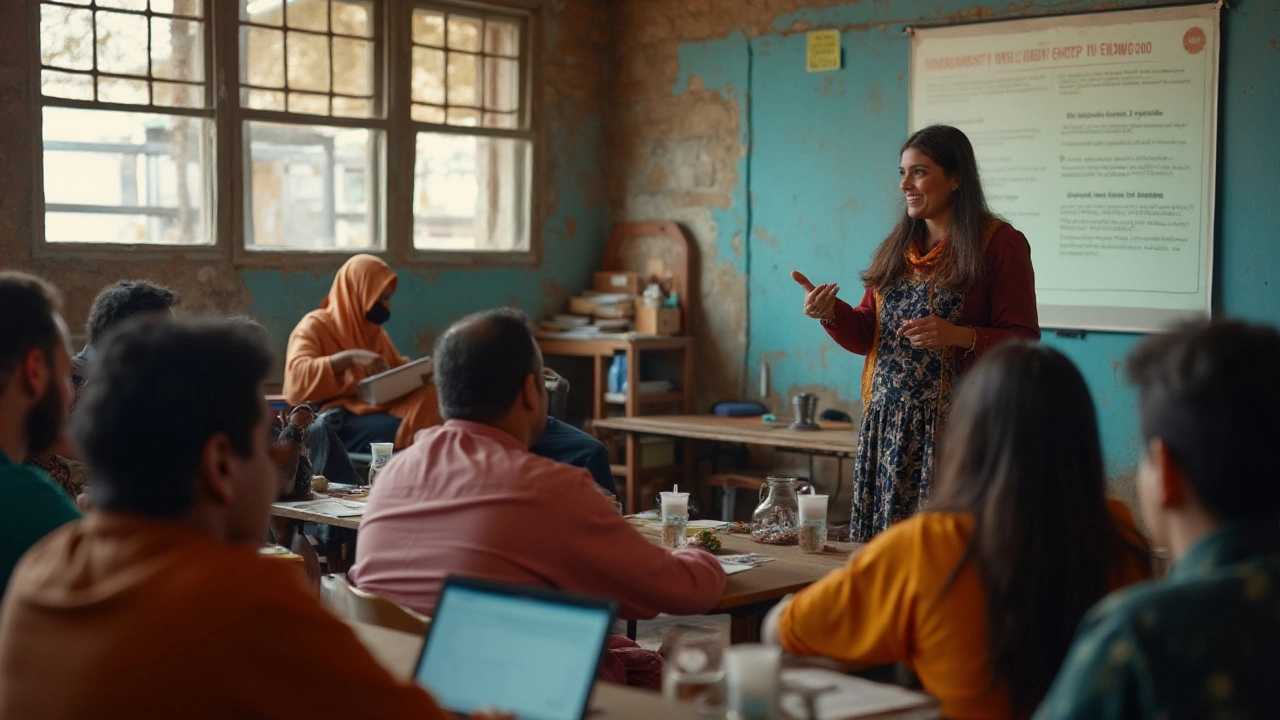Community outreach is a term that resonates with anyone passionate about making a difference. However, the essence of such work extends beyond just those two words. Like rainbow holograms reflecting the same light across different angles, community outreach shines through various terms, each depicting a facet of its indispensable role.
In this article, let’s peel back the layers and examine alternative terms that are often synonymous with community outreach. Uncovering these alternative labels not only offers a rich vocabulary but also creates pathways for fresh perspectives in how we engage with communities around us. Exploring this spectrum of expressions provides useful insights to anyone committed to social work, public service, and beyond.
- Understanding Community Outreach
- Alternative Terms Explored
- The Essence of Engagement
- Impactful Community Efforts
- Creative Nomenclature in Action
Understanding Community Outreach
Community outreach is more than just a phrase; it’s a promise of connection and support that forms the backbone of successful communal growth. At its core, it is about forming meaningful relationships with people who can benefit from direct service or support. This outreach can take place in various forms, including educational programs, healthcare initiatives, environmental projects, or cultural events. Each effort aims to bridge the gap between where people are and where they could be with the right support.
One might think of outreach as a symphony, where every participant plays a role to create harmony and inspire change. These activities are typically organized by non-profit organizations, governmental bodies, or even passionate individuals who have identified a need within their community. Engaging effectively means first understanding the specific needs and context of the community and then tailoring programs accordingly. The International Journal of Social Work suggests that "the alignment between community-driven ideas and strategic outreach efforts significantly enhances the impact of these initiatives."
Determining the target audience and the most impactful means of delivery are crucial steps in the outreach planning process. For example, health campaigns in rural areas might focus on vaccination drives, while urban initiatives could center around youth employment workshops. Precision in targeting ensures that resources are spent judiciously and the efforts reach their intended recipients. Outreach workers also often collaborate with community leaders to gain trust and increase participation, which is vital for the success of any initiative. This collaboration can be beautifully compared to weaving a tapestry, where each thread strengthens the fabric of society.
If we delve into some notable examples, libraries use outreach to increase literacy, conducting reading programs and distributing books in under-served neighborhoods. Schools may engage in outreach through after-school mentorship programs that provide additional support to students struggling academically. Furthermore, environmental organizations work on projects that encourage sustainable practices such as recycling and community gardening. In each instance, the essence is the same: offering support and creating opportunities for involvement.
A striking statistic from the National Collaboration for Health Equity highlights that effective community outreach can decrease local health disparities by up to 25%. This figure underscores the potential power of outreach to transform not just individual lives, but the dynamics of entire communities. Whether through a small group gathering or a wide-scale public awareness movement, the impact of community outreach is profound and far-reaching.
In summary, understanding community outreach involves recognizing its multifaceted nature and appreciating its unwavering commitment to service. It’s about coming together as one cohesive unit, dedicated to improving lives and fostering a sense of belonging. The more we explore and value this vital component of society, the more profound our collective growth and resilience will be.
Alternative Terms Explored
When delving into the realm of community outreach, the lexicon available is as diverse as the communities themselves. Each term employed to describe these initiatives carries unique connotations and highlights specific aspects of the endeavor, while ultimately working towards building strong connections and offering public service. One commonly used alternative is "community engagement," which shifts the focus more towards an interactive relationship between community members and outreach organizers. It suggests a two-way conversation wherein both parties contribute, listen, and share, fostering a richer exchange of ideas and mutual understanding.
Another popular term is "public service," which evokes a sense of duty and responsibility towards the societal collective. This phrase is often associated with government or nonprofit organizations that aim to improve the social welfare and well-being of the masses. In a similar vein, "social work" is employed to specifically refer to efforts concentrated on supporting individuals who may face challenges. This term carries a professional dimension as it is often linked with practitioners who have specialized training. Each of these alternatives captures a nuanced aspect of outreach that resonates with the distinct needs and goals of diverse initiatives.
Engagement efforts could also be described as "outreach programs"—a more structured and organized approach to reaching out. These programs are typically well-defined and might target specific sectors such as education, health, or employment, aiming for concrete outcomes. Here, creativity and clarity work hand-in-hand to name initiatives, ensuring stakeholders understand the goals.
According to the National Council of Nonprofits, "Effective outreach programs are structured to magnify impact through clear objectives and comprehensive strategies." This perspective shows how integral planning is to the success of these initiatives.
Community-oriented movements equally adopt terms like "civic engagement" to underline the political and societal elements of participation. This terminology often aligns with efforts that encourage voting, activism, or community leadership, emphasizing the power and responsibility of residents to partake in changing their environments. In a beautifully reflective manner, such terms symbolize vibrant participation instrumental in holistic change, showcasing how varied and dynamic the landscape of community efforts truly is. The symbiotic relationship between these terminologies and their corresponding strategies is an evolving discourse, consistently adapting to new challenges and dynamics faced in the social arena.

The Essence of Engagement
Engagement is the heartbeat of any project that is designed to connect a community with resources, education, or support. At its core, engagement is about building meaningful relationships where ideas and actions flow freely between organizations and the diverse groups they serve. The core of effective engagement lies in its ability to create an open dialogue, where every voice is heard, respected, and valued. By cultivating an environment that appreciates diversity, engagement efforts can connect with individuals on multiple levels, ensuring every person feels like a vital part of the community fabric.
This level of engagement requires careful planning and attention to detail. Successful initiatives often begin by understanding the unique characteristics and needs of the target community. By identifying key stakeholders and establishing trust within the community, organizations can tailor their outreach strategies to address pertinent issues and generate genuine interest and participation in programs. Effective engagement is not just about temporary involvement; it’s about fostering long-term relationships that result in sustainable community growth.
One well-known principle in engagement is the need for adaptability and flexibility. Community dynamics can change rapidly, and engagement strategies must evolve to remain successful. An organization's commitment to listening and learning from community interactions is crucial. This iterative process enables them to pivot and refine outreach efforts, ensuring they remain relevant and impactful. By keeping engagement efforts dynamic and responsive to change, communities are more likely to benefit from enhanced services and support.
As noted by renowned sociologist Dr. Evelyn Gertz,
"True community engagement is not about making decisions for the community but rather making decisions with the community."This mindset shift emphasizes the importance of collaboration and partnership. When community members are actively involved in decision-making processes, they feel empowered and invested in the outcomes. This collaborative spirit fuels active participation and collective action, driving positive change and fostering a sense of ownership over community initiatives.
Data supports the powerful impacts of engaged communities. A recent study analyzing various community programs showed that those with strong engagement strategies saw a 25% increase in program participation and a 30% rise in community satisfaction rates.
| Metric | Increase (%) |
|---|---|
| Program Participation | 25% |
| Community Satisfaction | 30% |
Impactful Community Efforts
Impactful community efforts are the heartbeat of community outreach. These efforts are designed to create significant and tangible differences in people's lives by addressing their specific needs and challenges. One shining example is the transformation of urban landscapes through community gardening projects. Such initiatives not only beautify neighborhoods but also promote sustainability and improve mental well-being for its residents. By providing spaces where members can gather, share resources, and cultivate food, community gardens become epicenters of social interaction and learning.
The success of impactful community efforts often lies in their adaptability and response to ever-changing social dynamics. A pivotal factor is the active engagement of local community members in both the planning and execution phases of projects. For instance, various studies highlight how participatory planning in public health initiatives has not only increased attendance but also enhanced trust and cooperation among different stakeholders. In a children’s health outreach initiative conducted by the WHO, involving the local clinics and schools, immunization rates improved by 20% over 2 years. These numbers reflect a harmonious blend of local knowledge and external resources where everyone involved becomes a stakeholder in the community’s future.
The Role of Technology in Community Efforts
Technology today plays a crucial role in enhancing the reach and impact of public service projects. Social media platforms, for instance, have become critical in mobilizing volunteers, raising awareness, and sharing success stories far and wide. Through these digital channels, community efforts often find larger audiences, inviting even global participation. Take, for example, the social media campaign #TrashTag, where thousands around the world proved the power of simple, localized action by cleaning up and beautifying neglected areas."Our ability to reach unity in diversity will be the beauty and the test of our civilization." – Mahatma GandhiEfforts backed by technology demonstrate that distance is no longer a barrier to effect change. Innovative apps have emerged, connecting those in need with resources or volunteers. One notable app, Be My Eyes, links visually impaired individuals with sighted volunteers through video calls, offering assistance that spans across continents.
The metrics of successful community efforts are best measured through the stories of impact they leave behind. From the once-struggling families now thriving due to effective social aid programs to cities revitalized by public art installations that instill a sense of pride, these are the landmarks of positive transformation. Communities that foster impactful efforts not only elevate the quality of life but also set precedence for nurturing resilient, inclusive societies. Every effort, big or small, adds a vibrant thread to the fabric of communal life, weaving a tapestry rich with resilience and hope.

Creative Nomenclature in Action
When considering the vast tapestry of community outreach, language plays a pivotal role in how we perceive and engage with communities. The term 'community outreach' itself may sometimes feel too formal or restrictive, prompting organizations and individuals to concoct more creative names that capture the vibrant and dynamic nature of their efforts. Imagine a community arts program that chooses to brand its outreach as 'Creative Connections,' placing emphasis on the building of relationships through the medium of art. This naming not only speaks to the method but also the desired outcome—a stronger, more cohesive community.
Creative nomenclature often stems from the desire to resonate more deeply with specific target audiences. Nonprofits and local initiatives alike might find themselves brainstorming names that reflect cultural sensitivity, accessibility, or a specific project goal. For instance, a literacy initiative might choose 'Pages of Hope,' providing a narrative that aligns with their mission of empowering through reading. This approach taps into the story-telling elements that humanize and make outreach relatable. Notably, a study by the University of Michigan found that programs aligned with linguistically and culturally relevant names attracted 20% more participants than those with generic terminology.
The choice of naming in community engagement endeavors can significantly influence public perception and involvement. It transforms a simple act of reaching out into a shared communal task, often sparking curiosity and a desire to participate. Leveraging such terms can also align with branding strategies, creating a memorable imprint on the audience's psyche. Take 'The Green Hand' initiative—a conservation-driven project that cleverly intertwines environmental focus with the act of lending a hand. These names linger in minds long after the events have concluded, creating lasting impressions that echo through community narratives.
"Words are, in my not-so-humble opinion, our most inexhaustible source of magic, capable of both inflicting injury and remedying it." - J.K. Rowling
In some cases, adopting innovative nomenclature is not simply a matter of setting marketing apart but reflecting an evolution in the public service sector itself. As sectors grow and change, so too do their demands for relatable and reflective communication tools. The term 'Public Partnerships' might be utilized to highlight the collaborative aspect of outreach work, thereby inviting stakeholders into the process of communal empowerment. By altering perceptions, we can transform simple outreach into a joint mission, fostering a two-way street where communities both give and receive.
Finally, by experimenting with diverse and evocative names, there's an opportunity to stay relevant in rapidly shifting social and cultural landscapes. Shifting a project's identity to sound more inclusive or embracing evolving language trends not only refreshes a legacy program but meshes with contemporary sensibilities. This tends to bolster morale internally within groups about how they view their own work, making it invaluable for social work entities globally. So, as language continues to evolve, so will the labels we assign to these noble endeavors, ensuring they remain as dynamic and impactful as the communities they serve.
